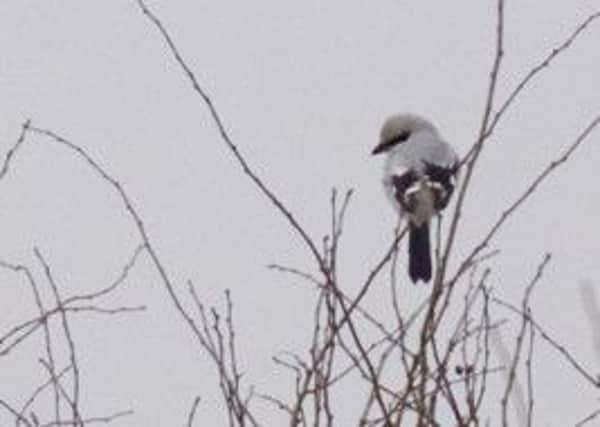Birdwatch: Great grey shrike


Visitors to the Midhope Moor Watchpoint to the west of Sheffield have been able to see one of these brutally efficient hunters in action.
The shrike sits silently on a high branch or hedge top before suddenly swooping down on any passing small bird or mammal and despatching it with a bite from its hooked beak. It carries the corpse to a nearby thorn bush or even a barbed wire fence, impales the corpse and eats its fill. Any surplus food is stored in a ‘larder’ to be eaten later.
Advertisement
Hide AdAdvertisement
Hide AdSo far the Midhope bird has been seen to catch and impale a number of small birds including a robin while another, on Beeley Moor near Chesterfield, is proving equally efficient.
Although only slightly larger than a blackbird one has been recorded as killing a stoat. When hunting larger mammals the shrike lands close by to avoid being bitten, then circles its potential victim while attempting to bite the back of its neck and cut the spinal cord. There’s a record of one battle where a shrike bit a rat 117 times before the latter was subdued.
The great grey shrike is a winter visitor to this country, mostly from Norway, with an average of 150 records a year. In winter they are solitary birds, carving out a territory on open countryside or in clear fell forest clearings which is held until as late as April or May when they return to breeding sites.
Some individuals will return to these winter territories for several years, Langdale Forest in North Yorkshire is one such site with the clearing at Stony Knoll particularly favoured while others are on Thorne Moors near Doncaster and at Budby Common, North Nottinghamshire. Great grey shrikes have been reported at all these sites this winter.
Advertisement
Hide AdAdvertisement
Hide AdA Greenland white-fronted goose continued to be seen this week in the Water Lane area of Flamborough village and another on Harwood Dale Lake near Scarborough. Seven species of geese were at Nosterfield Nature Reserve, North Yorkshire; white-fronted, tundra bean, brent, bar-headed, pink-footed, greylag and Canada. The drake American wigeon continued to be seen at Nosterfield while drake green-winged teals were at the North Cave Wetland in East Yorkshire.
The rough-legged buzzard is still being seen at Grindale near Bridlington while a juvenile was over the Highwood Brow viewpoint at Wykeham Forest, with several goshawks.
The Richard’s pipit was seen in fields at Hyburn Wyke north of Scarborough and a male ring ouzel at Roxby. More white-winged gulls were reported in roosts while an adult Kumlien’s gull, a North American race of Iceland gull, was seen in a field at Knapton Lane, York.
The warm weather this week encouraged great spotted woodpeckers to start drumming, overwintering chiffchaffs and skylarks to burst into song while pairs of oystercatchers were back on breeding territories.